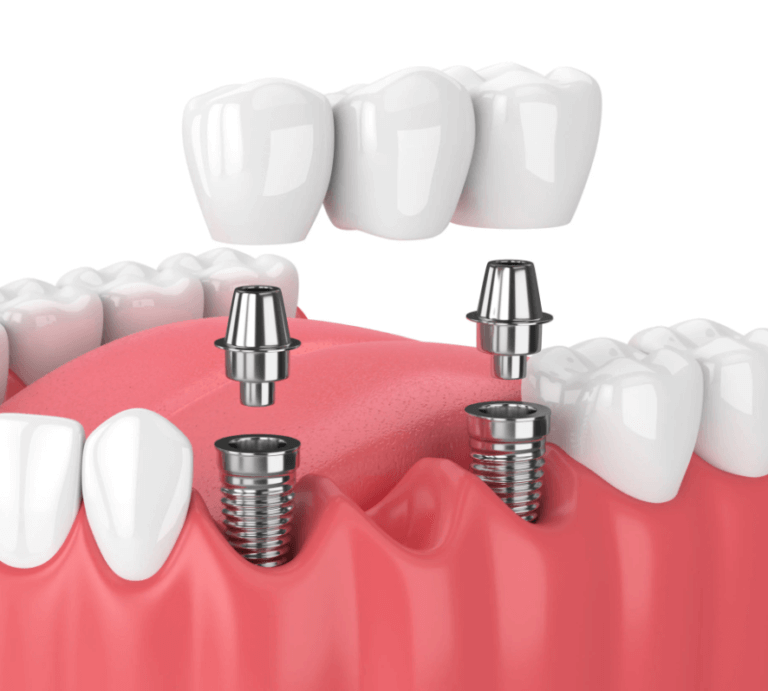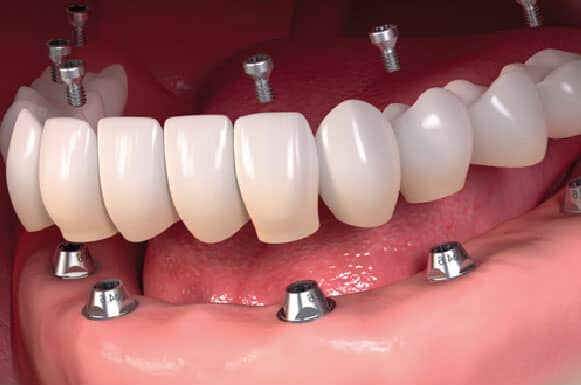Fallen Out Dental Implant Bridge

What Is A Fallen Out Dental Implant Bridge?
A dental implant bridge is a type of dental prosthetic that is used to replace multiple missing teeth. It consists of a series of small titanium posts, called dental implants, that are surgically placed into the jawbone using computer guided surgery or freehand methods. These implants act as anchors for a custom-made bridge, which is then attached to the implants. The bridge is made to look and function just like your natural teeth, making it a great option for people who have lost one or more teeth due to injury, disease, or other reasons. It can help restore your ability to chew and speak properly, and also improve the appearance of your smile. While dental implant bridges are designed to be long-lasting and durable, they may occasionally become loose or fall out altogether.
When a dental implant bridge falls out, it can be a cause for concern for patients who rely on the implant bridge for normal oral function and appearance. Before you contact a Toronto dentist to examine A Fallen Out Dental Implant Bridge, there are some things you should know as a patient:
- Why Did My Dental Implant Bridge Fall Out?
- Signs And Symptoms Of A Dental Implant Bridge Falling Out
- Treatment Options For A Fallen Out Dental Implant Bridge
- How To Prevent A Dental Implant Bridge Falling Out
- Managing A Fallen Out Dental Implant Bridge Until You Can See The Dentist
If you have questions about A Fallen Out Dental Implant Bridge or other dental problems, please contact us for more information.
Why Did My Dental Implant Bridge Fall Out?
There are several reasons why a dental implant bridge may become loose or fall out altogether. These include:
- Screw loosening: One of the most common reasons for a fallen out dental implant bridge is screw loosening. This can occur if the screw that attaches the bridge to the implant post is not inserted with enough torque during the initial placement. Typically, 15 newton-centimeters is required for proper insertion. Over time, the screw may gradually become loose and eventually cause the bridge to come off. Or perhaps an inadequate amount of torque was used at the time the dental implant bridge was installed.
- Prosthetic misfits: Another reason why a dental implant bridge may fall out is due to prosthetic misfits. This occurs when there is a discrepancy between the fit of the dental implant bridge onto the underlying dental implant, preventing the implant bridge from seating properly. Prosthetic misfits can result from errors in manufacturing or improper placement of the bridge onto the implant post.
- Failed Osseointegration: Osseointegration is the process of the dental implant fusing with the jawbone. If this process fails, it can result in a loose dental implant and dental implant bridge. Osseointegration failure can happen due to inadequate oral hygiene, smoking, osteoporosis, poor bone healing, genetics or other metabolic disorders.
- Trauma or injury: A dental implant bridge may also become dislodged due to trauma or injury to the mouth. This can occur from a fall, sports injury, or other accident that affects the implant site.
It’s essential to identify the cause of the dental implant bridge falling out to determine the best course of action for treatment. Your dentist can help you diagnose the cause and provide the necessary treatment to restore your implant bridge. If you have further questions about A Fallen Out Dental Implant Bridge, please contact us.
Signs And Symptoms Of A Dental Implant Bridge Falling Out
If you have a dental implant bridge, it’s important to be aware of the signs and symptoms of a fallen out bridge. These include:
- Visible tooth gap: The most obvious sign of a fallen out dental implant bridge is a visible gap where the implant bridge used to be. You may also notice that the implant post is exposed.
- Loose bridge: Before the bridge falls out completely, you may notice that it feels loose or wobbly in your mouth.
- Discomfort or pain: If the bridge becomes dislodged, it can cause discomfort or pain around the implant site. You may also experience sensitivity to hot or cold temperatures.
- Changes in bite or chewing: When a dental implant bridge falls out, it can affect your ability to bite and chew normally. You may notice that your bite feels uneven or that food is getting stuck in the gap.
- Gum swelling or inflammation: If the fallen out dental implant bridge is due to poor oral hygiene, you may experience swelling or inflammation around the implant site. This can be accompanied by redness and tenderness in the gums.
If you experience any of these signs or symptoms, it’s important to contact your dentist right away. They can evaluate the situation and recommend the appropriate treatment to restore your dental implant bridge. If you have further questions about signs or symptoms of A Fallen Out Dental Implant Bridge, please contact us.

Treatment Options For A Fallen Out Dental Implant Bridge
If your dental implant bridge has fallen out, your dentist will need to assess why it fell out and recommend the appropriate treatment. Here are some common treatment options:
- Implant bridge reattachment: In some cases, it may be possible to reattach the fallen out dental implant bridge. Your dentist will disinfect the dental implant bridge bridge and implant post before screwing them back together. This treatment option is only possible if the bridge is still in good condition and hasn’t been damaged.
- Bridge replacement: If the fallen out dental implant bridge is damaged or cannot be reattached, your dentist may recommend replacing it with a new bridge. This involves taking physical or digital impressions of the implant site to create a new bridge that fits properly.
- Implant replacement: If the implant post itself is damaged or has become infected, your dentist may recommend removing it and replacing it with a new implant post. This can be a more involved procedure if there is significant bone loss around the implant site. Your dentist may recommend bone grafting to rebuild the bone structure before placing a new dental implant.
Your dentist will recommend the appropriate treatment based on the cause and severity of the fallen out dental implant bridge. It is important to follow their recommendations and maintain good oral hygiene to prevent future issues. If you have further questions about treatment options for A Fallen Out Dental Implant Bridge, please contact us.
How To Prevent A Dental Implant Bridge Falling Out
While some cases of a fallen out dental implant bridge may be due to unavoidable circumstances, there are steps you can take to help prevent this from happening. Here are some ways to maintain the health and stability of your dental implant bridge:
- Good Oral Hygiene: Maintaining good oral hygiene is crucial in preventing gum disease, which can lead to implant failure. The Waterpik waterflosser is also a terrific adjunctive tool to keep the area around the dental implant bridge clean.
- Regular Dental Visits: Regular visits to your dentist can help identify and address any issues with your implant bridge before they become more serious.
- Wearing a Mouthguard: If you grind or clench your teeth, wearing a mouthguard at night can help protect your implant bridge from damage.
- Choosing a Qualified Implant Dentist: Choosing a qualified and experienced implant dentist can help ensure that your implant bridge is placed correctly and reduces the risk of complications.
By following these tips, you can help prevent a dental implant bridge from falling out and maintain the health and stability of your dental implant for years to come. If you have further questions about how to prevent an Dental Implant Bridge from falling out, please contact us.
Managing A Fallen Out Dental Implant Bridge Until You Can See The Dentist
If your dental implant bridge has fallen out and you are unable to see your dentist right away, there are some steps you can take to manage the situation until you can receive professional treatment. Here are some tips:
- Keep the dental implant bridge in a safe place: If the bridge has come off completely, keep it safe in a clean container to avoid losing or damaging it. Do not forget to bring it with you to your dental appointment.
- Practice good oral hygiene: Keeping the area around the exposed dental implant site as clean as possible can help prevent peri-implantitis and other unwanted complications. Brush gently. If you do not already have a Waterpik waterflosser, buy one and use it often. A waterflosser is a terrific adjunctive tool to keep the dental implant bridge clean. Rinsing your mouth with warm salt water or mouthwash can help reduce infection, inflammation and alleviate toothache pain. You can buy any mouthwash available at your pharmacy or health foods store. Alternatively, you can mix a teaspoon of salt in a cup of warm water and swish the solution around your mouth for about 30 seconds before spitting it out.
- Avoid chewing on that side: Avoid eating or drinking on that side of the mouth until you can see your dentist, as this can cause further damage.
- Use over-the-counter pain medication: Over-the-counter pain medication, such as Advil (ibuprofen) or Tylenol (acetaminophen), can help relieve pain around a loose dental implant bridge. Follow the instructions on the label and do not exceed the recommended dose. Unless you have a health condition that prevents you from taking either ibuprofen or acetaminophen, the absolute maximum dose that I recommend patients take for the worst dental pain is 600 mg ibuprofen combined with 1000 mg acetaminophen every 4 to 6 hours.
It’s important to see your dentist as soon as possible to receive professional treatment for a fallen out dental implant bridge. In the meantime, these tips can help manage the situation and minimize discomfort. If you have further questions about managing A Fallen Out Dental Implant Bridge, please contact us.

